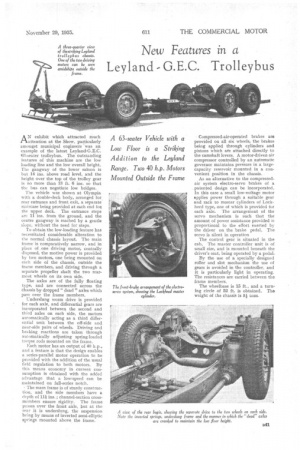New Features in a
Page 55

If you've noticed an error in this article please click here to report it so we can fix it.
Leyland-G.E.C. Trolleybus
A 63-seater Vehicle with a Low Floor is a Striking Addition to the Leyland Range. Two 40 h.p. Motors Mounted Outside the Frame AN exhibit which attracted much attention at the Show, particularly amongst municipal engineers was an example of the latest Leyland-G.E.C. 63-seater trolleybus. The outstanding features of this machine are the low loading line and the low overall height. The gangway of the lower saloon is but 14 ins, above road level, and the height over the top of the trolley gear is no more than 13 ft. 6 ins, so that the bus can negotiate low bridges.
The vehicle was shown at Olympia with a double-deck body, arranged for rear entrance and front exit, a separate staircase being provided at each end foa the upper deck. The entrance steps are 11 ins, from the ground, and the centre gangway is reached by a gentle slope, without the need for steps.
To obtain the low-loading feature has necessitated considerable alteration to the normal chassis layout. The main frame is comparatively narrow, and in place of . one driving motor, centrally disposed, the motive power is provided by two motors, one being mounted on each side of the chassis, outside the frame members, and driving through a separate propeller shaft the two rearmost wheels on its own side.
The axles are of the fully floating type, and are conneeted across the Chassis by dropped" dead "axles which pass over the frame members.
Undersiung worm drive ia provided for each axle, and differential gears are incorporated between the second and third axles on each side, the motors automatically acting as a third differential unit between the off-side and near-side pairs of wheels. Driving and braking reactions are taken through automatically adjusting spring-loaded torque rods mounted on the frame.
Each motor has an output of 40 lap., and a feature is that the design enables a series-parallel motor operation to be provided with the addition of the usual field regulation to both motors. By this means economy in current consumption is obtained with the added advantage that a low-speed can be maintained on full-series notch.
The main frame is of sturdy construction, and the side members have a depth of 11-i ins. ; channel-section cross members ensure rigidity. The frame passes over the front axle, but at the rear it is underslung, the suspension being by means of inverted semi-elliptic springs mounted above. the frame.
Compressed-air-operated brakes are provided on all six wheels, the brakes being applied through cylinders and pistons which are attached directly to the camshaft levers. A motor-driven air compressor controlled by an automatic governor maintains pressure in a largecapacity reservoir mounted in a convenient position in the chassis.
As an alternative to the compressedair system electro-servo brakes of a _ patented design can be incorporated. In this case a small low-voltage motor applies power through a suitable gear and rack to master cylinders of Lockheed type, one of which is provided for each axle. The arrangement of the servo mechanism is such that the amount of power assistance provided is proportional to the effort exerted by the driver on the brake pedal. The servo is silent in operation The control gear is situated in the cab. The master controller unit is of small size, and is mounted beneath the driver's seat, being operated by a pedal.
By the use of a specially designed roller and slot mechanism the use of gears is avoided in the controller, and it is particularly light in operating. The resistances are carried between the frame members.
The wheelbase is 15 ft., and a turning circle of 52 ft. is obtained. The weight of the chassis is 5i tons.




























































































